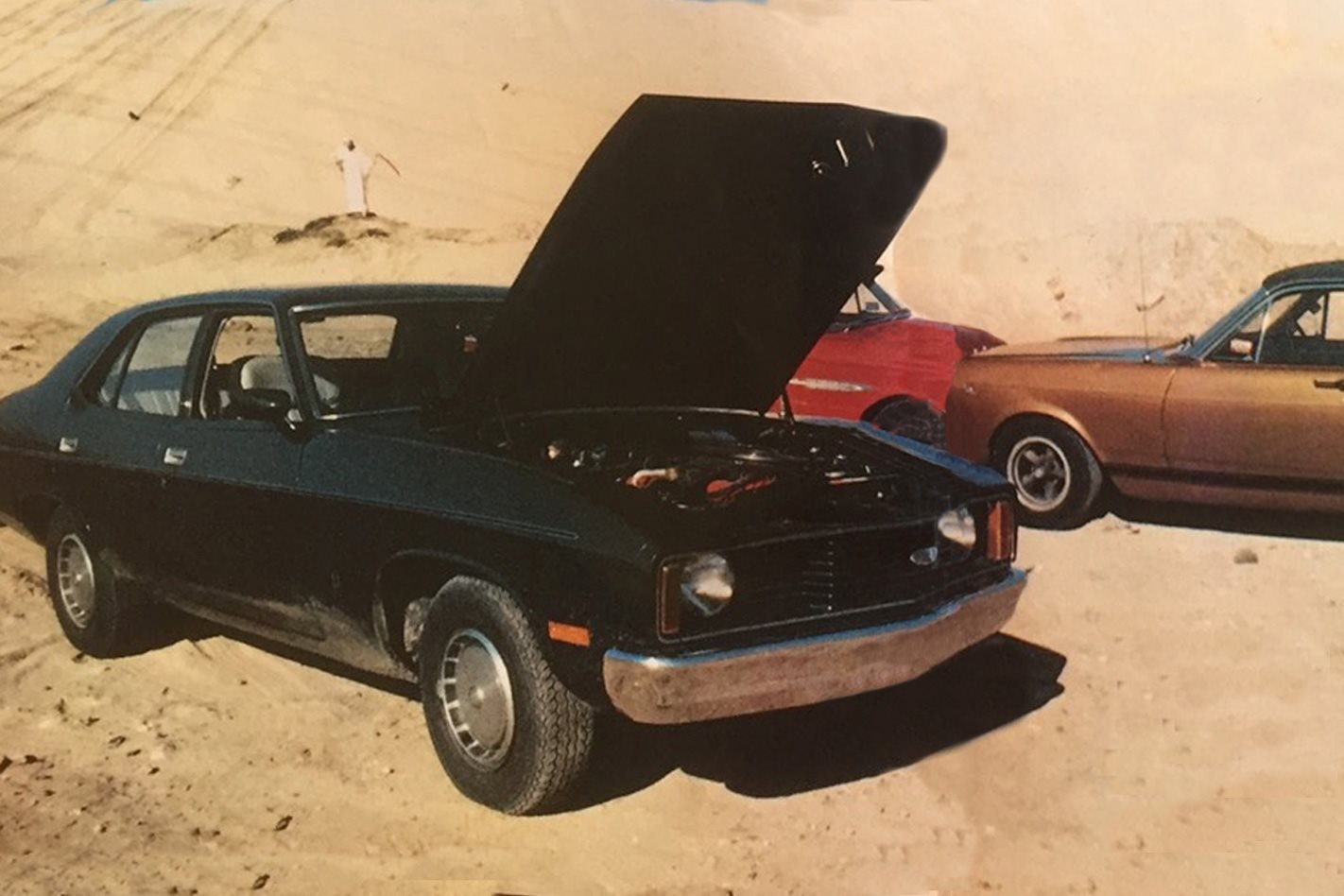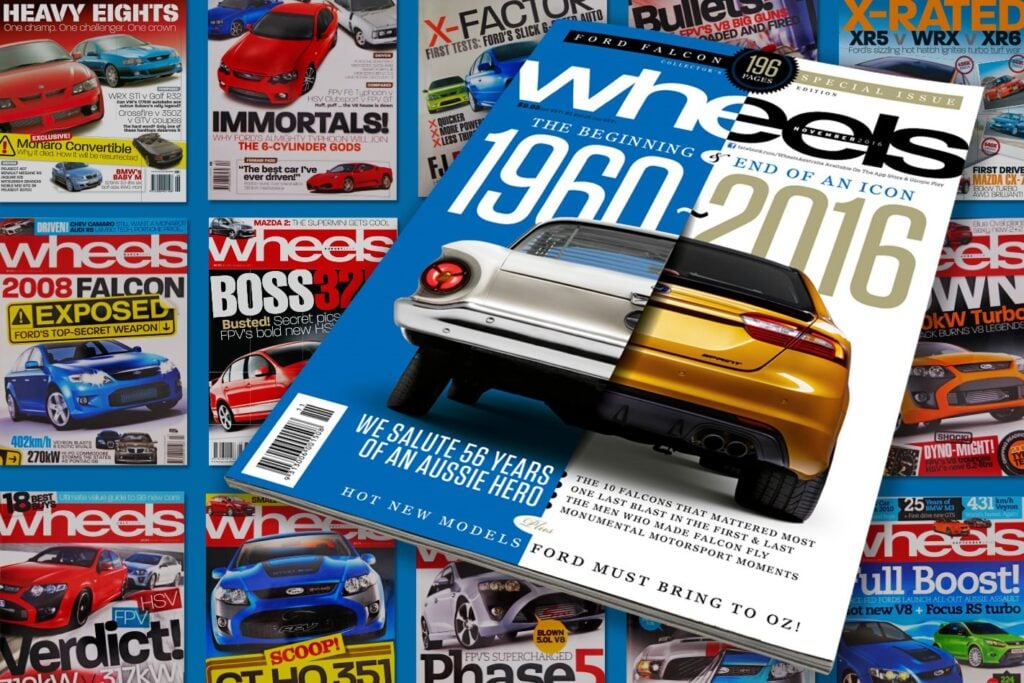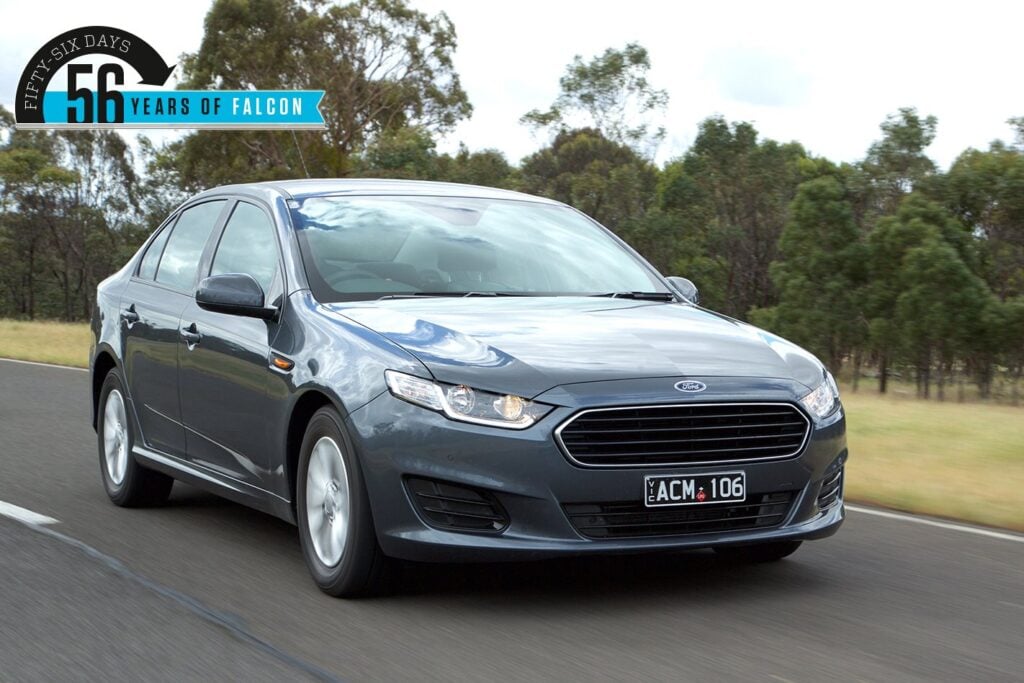First published in the July 1978 issue of Wheels magazine, Australia’s best car mag since 1953.
Ford’s third-generation Falcon, the XC, provided Wheels with the perfect opportunity to reflect on the car’s 20-year evolution.
IT CAME In September, 1960, the first real competition for the Holden and virtually doubled Ford’s share of the market in 18 months before the truth became apparent and the lousy durability became obvious end plunged Ford into the red.
In 1960 the XK Falcon was a very modern car if you used the FB Holden as a yardstick. It was wider and longer, and up to the minute in terms of its huge glass areas, almost flush lower body/green house and that low bonnet with the headlights included with the grille.
Holden’s FB, in contrast, was a quaint collection of Chevrolet styling circa 1955 to 1957 with semblance of tail fins and that terrible wraparound windscreen.
The Falcon offered automatic transmission as standard and it both outperformed and out handled the Holden … until the suspension and clutch began to deteriorate.
In concept, the Falcon was Ford of America’s answer to the European cars which were pouring into the USA in the late fifties. Introduced in late 1959, the Falcon, General Motors’ rear-engined, aircooled Chevrolet Corvair, and (a couple of months later) Chrysler’s more powerful Valiant did stem the imported tide until the home grown compacts grew in size. For Ford Australia, the Falcon was the answer to the Holden it had been looking for. Ford Zephyr was the right size and specification, but it was too expensive. The Falcon was different. And so it proved. An instant success, it suffered badly after the honeymoon was over but then a masterful development program which improved the durability once more turned Ford ‘s fortunes and made the Falcon Australia’s top seller in 1977.
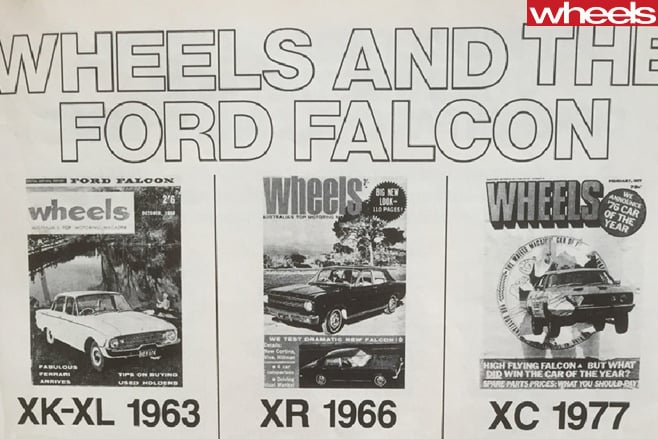
In concept the car has hardly changed, superficially anyway. It is still about the same size and still has a water cooled six cylinder engine — in the most popular basic form — up front and driving the rear wheels through a three speed manual transmission with steering column gear change. Weight has gone up by almost half as much again and this has forced substantial increases in engine capacity if only to maintain the same performance level. That alone improved it. Of course, economy has suffered with every increase in weight and engine capacity.
The model range and the choice of options has grown enormously. Today you can build your own Falcon and have the choice of a fleet operators’ special or a quite grand touring car with standards of braking, acceleration and roadholding beyond the dreams of the engineers who created the Falcon as an economical, compact car. For Australians the Falcon will live on for at least another five years. The present car, which grew out of the 1972 XA will be replaced by the XO in April/May 1979. That will be the last all-Australian car to come from one of the major manufacturers. So, before the present Falcon disappears from the showrooms we thought it appropriate to drive the three stages of its development. Yes, change Is progress in most areas.
“Because we live very much for the present it is easy to overlook the real achievements of the modern car … few products have improved as much.”
“THEY DONT make cars like they usedter, mate.”
Thank God!
A direct comparison between the 1960 XK, 1967 XR and 1978 XC Falcon showed the enormous changes which have been forced on Ford. Subjectively, the image has changed from a discreet, gentle American abroad, through aggressive Australian to a transparent attempt at copying European sophistication. A car enthusiast who’d been kept in suspended animation for 20 years when confronted by the three cars would be excused for thinking Australians had changed genetically as well as socially.
The XK we used for the comparison became an XL during the morning. For the purposes of the story this hardly matters since the two models were virtually identical apart from the rear roof line. We collected the XK from Clive Philip Motors on Sydney’s infamous Parramatta Road at Homebush. The car was rough and running on five cylinders because it hadn’t been prepared for sale. After struggling with an automatic transmission which refused to change out of first gear, we were stopped by a motorcycle policeman who didn’t see the humor in the mobile bushfire with bald tyres.
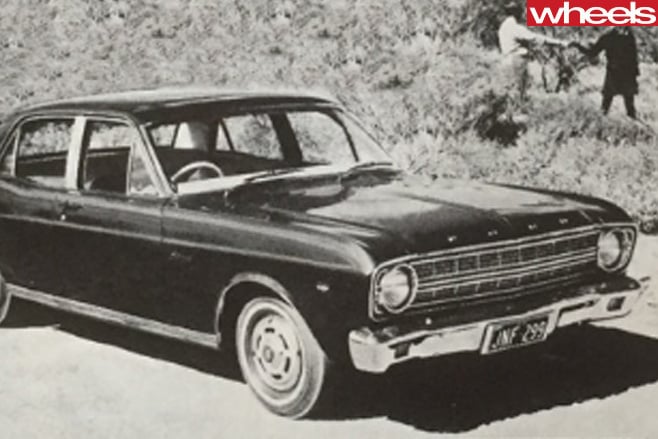
The XL was straight, clean and performed well considering its alarming thirst for fuel and oil – largely due to its five-cylinder engine.
lt was a tired old car, but at $499, honestly represented. The first few minutes was spent deciding if it was horribly worn out, indescribably bad, or just representative of the standards applicable to 1963. The next hour driving to the photo location was spent assessing worn components and mentally restoring them to determine the standards of the day.
As a Futura, the XL offered a significant touch of European design – bucket seats. The first thing we noticed was the lack of travel in the seats. They didn’t move far enough to the rear for a comfortable driving position but did leave plenty of room in the rear. Our suspended animation enthusiast has an immediate impression of a man with conventional legs and extremely short arms.
And the bucket seats – what a revelation they were back in the early’60s! Holden’s EJ Premier was talked about as a “sports car” because it had bucket seats. In fact, the Falcon’s seats aren’t buckets, just separate seats, but the beggars of 1963 couldn’t be choosers. A sports car was a car with separate front seats, so the Futura was Ford’s first attempt at the Aussie Supercar based on a mums’n’dads model.
On the road, the two-speed (Tree-bar) transmission is remarkably good. Although there’s lag of about 1000rpmbetween drive and overrun, the transmission locks easily and the car moves quite quickly. Bearing in mind the car we were driving was running on five cylinders most of the time and blowing more smoke than the Adelaide Hills in February, the performance was still enough to keep the car up with the traffic of 1978.
It must have been a boomer in 1963.
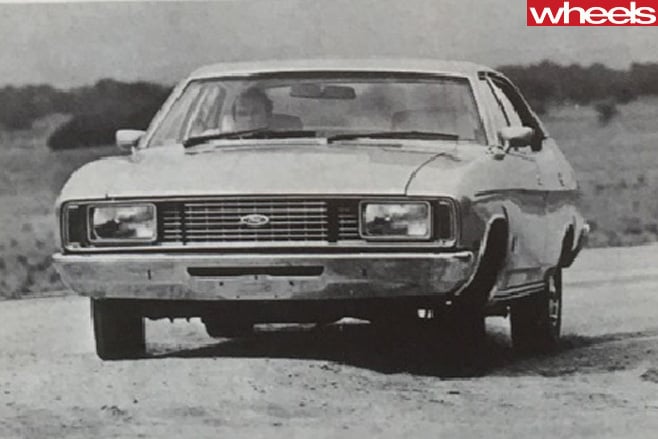
Considering the brakes were unboosted and pretty basic, they work well at conventional traffic speeds. However, unassisted brakes on a single line system would be more dangerous today than in their hey-day. With power boost, tricky pads, ventilated disk brake cars standing on their bumpers two metres in front, you need more than cocoa tins for stopping in 1978.
The XL may have looked low and lean in 1963, but in reality it is low and leans. All it needs is a pinball TILT light on the dash to accentuate the severity of body roll in mild corners and a rope for the rats to leave the sinking ship when driving briskly. If you don’t believe the degree of lean on an old Falcon (albeit with very ancient shock absorbers), try remembering the advertising slogan for the XM. It was “Trim, Taut and terrific”. Even Ford knew the worst.
After our short time with the XL it was easy to see why the XK/XL Falcon became popular so quickly. Handling isn’t significantly worse than any other Australian cars of the era, and performance is definitely better and it looked far more modern than the Holden. The clutch and suspension problems had yet to rear their ugly durability head.
The XR became arguably Ford Australia’s first real supercar in its GT form. A fully imported 289 V8 engine with floor gearchange (another sports car feature), separate seats, trick paint, tyres and suspension. It burst on the scene with a conclusive win at Bathurst in 1967. By today’s gentle powerhouse standards, it is still a hot-rod.
Ford didn’t have provision for a floor gearchanger on the production line, so the GT had a hole in the floor, cut with an oxy torch. The gear linkage, held together with a makeshift collection of plastic washers is very sloppy, although its owner (Mac Douglass, Editor of sister magazine TWO WHEELS) says new washers improve the gearchange considerably.
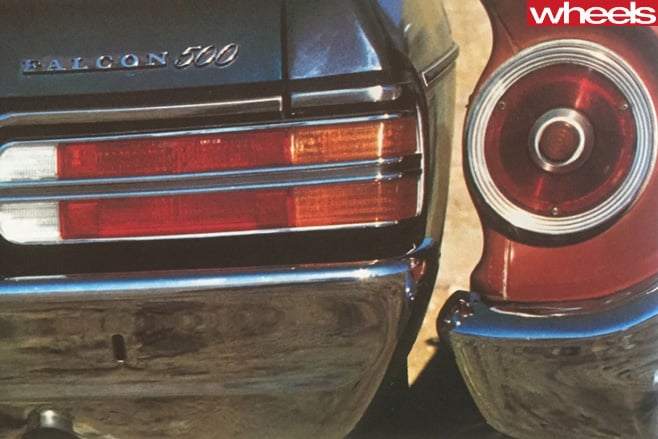
The test car was prepared for Bathurst but never raced and has lasted the 10 hard years of driving well. Rattles have started to show and the silent muncher has left his rusty stains in all the predictable places – more so than in the XL.
Once the delightful 289 V8 burbles into life it’s easy to understand why the first GT had such a dramatic effect on Aussie supercars. It lives and breathes machismo demanding almost the same physical prowess and compromises of a pre-war sports car while hiding behind the appearance of a family hack.
It’s a car for men.
The XC1/2 is a car for everyman. Progress brought about by the success of the XA marketing program and dwindling Holden sales (more Holden’s fault, not Ford’s genius) gave Ford the confidence it needed to embark on a large number of improvement programs. How many of these have been spurred on by market reaction, stiff overseas competition, cash in the till from good sales or an honest belief in building better cars is hard to determine. The end product, however, bears virtually no relationship to the two earlier models we drove although it still follows the same basic engineering layout. No design revolution here.
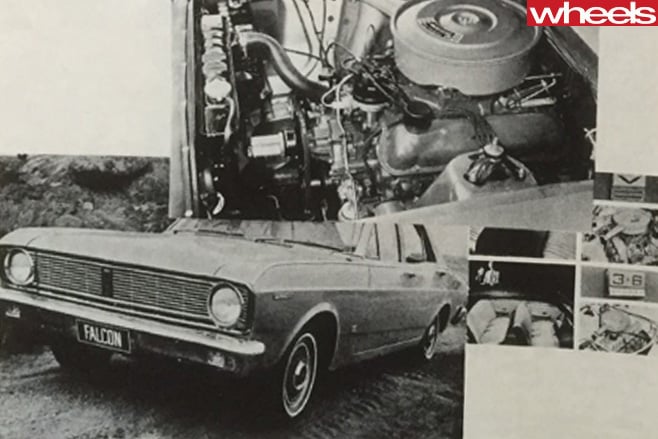
Now that our suspended animation enthusiast has been resurrected to the world of 1978 he can be truly amazed that the three cars can be made by the same factory.
The steering wheel fits without pressing against his chest, controls are lighter in some cases, heavier in others (steering) and the overall feel is one of balance. The relationship between the controls has moved closer to a harmony with the needs of the body to exert as little effort as possible while feeding back enough information for the b5ain to make more accurate decisions. Oise, vibration and harshness have been attacked at the engineering level not the olde worlde English method of thick padding and Oak veneer. Panels are designed so they don’t resonate, and rubber bushes have been designed so they don’t transmit the frequency they are isolating.
The XC1/2 is subliminal technology. There’s no contest between the three cars. It is quieter, quicker, more comfortable and fits the human frame better in temperament as well as shape. The XR may be more responsive but the compromises of driver strength and car noise is intolerable. However it does use more petrol, visibility isn’t anything like as good as the XK/XL and it does cost more.
Ford has come a long way since the XK first challenged Holden’s supremacy in this tiny market. Changes haven’t moved as quickly as we would have liked, but the size of the Australian market hasn’t left much room for elaborate research and development. If Ford hasn’t succeeded with the XC1/2 then it is due in part to imitation of the features of many European and Japanese cars which have worried the local builders for so long.
And imitation is the sincerest form of flattery.
Check out Wheels Archive online now for other great Ford Falcon features and more from decades past!
Simply log in here using your existing MagShop account or create a FREE account and select this article from the homepage.
Don’t have a MagShop account?

Have a MagShop account?


